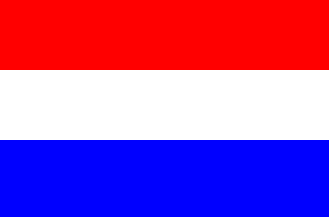- Productie: st Trading Hats
- More about Vietnam
- Redactie: Roby Bellemans
A bit about Việt Nam
Meetingpoint opening

Openings are very formal in Vietnam, there is a stage with a microphone, a beautiful lady,
dressed in
Ao Day as MC and all people sitting neatly on a chair with a beautiful white cover. Anyone
who even
has something to do with the exhibition may then speak. You must be willing to understand
by
listening very active, because however much the technician does his best, the technical
equipment
rarely works. In addition to this, many of the speakers have little or no experience in public
speaking.
I think this is not really important, you know who is thanking who etcetera. It is especially
exciting to
look at each other. After all it is a party with snacks after the speeches.
Flor Bex, the former director of Antwerp ICC (International Cultural Centre) and founder of
the
Muhka (Museum of Contemporary Art Antwerp), decided very unusual, on a certain moment
to
abolish the opening ceremonies at the ICC. He preferred to use its money for exhibitions. I
was in the
position to work with him for a while, which has greatly influenced me, including influencing
me on
on how to do openings. For the director of the HCMC Fine Art Museum my approach
therefore came
as something of a complete surprise. Especially when I told her that only she and the Consul
General
might have a speech, otherwise I would be the only one saying something. She asked me:
"Don't the
artists say something?". No, they wouldn't.
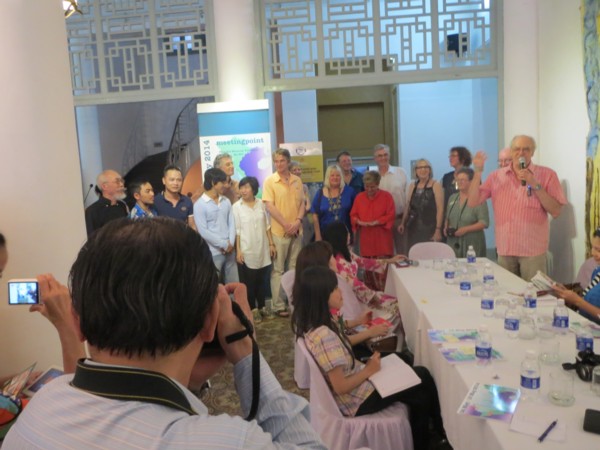
It was not my intention to follow the standard protocol. With more than 30 participating artists it would become a very long event. I'd rather try to open the exhibition in a literally and figuratively way. Very often people say that they do have an interest in art, but they understand so little about it. This could be easily solved by the approach of Johannes Itten, one of the best art lecturers in history. Itten who taught at Bauhaus in 1920, a few years before the first Academy was founded in Vietnam (Ha Noi 1925), asked his students during a lesson to draw lemons. Those were realistic drawings in which the lemons were represented exactly as they look. "And now, said Itten, you have to represent them as they are! Not as they look." Students understood nothing from what Itten said, so he took a few lemons, cut them in half and put the students half a lemon in their mouth. Then pointing at their distorted faces Itten said: "That is what I want to see on the canvas! When people see your work, they have to look that sour! ". How to represent an abstract a form is easy to understand, everybody knows and uses smileys. And that was the opening,

More or less, because such a story you should obviously bring very graphically and in this
case in
three languages. Luckily I had the help of Tranh Phuong Trinh, my former internee who
translated
my Dutch text in word and gesture into English and Vietnamese. Not that she speaks Dutch,
but she
always understands immediately what I want to say. She was especially flown from Kuala
Lumpur
where she works in the field of international law, but I think she would do much better doing
this
kind of work ...
.
We also had Simon Borst who shows that an artists works with what is available. You can
paint even with chocolate...it smells good and tastes great.
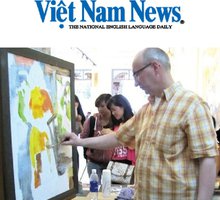
And there was a long after-party......
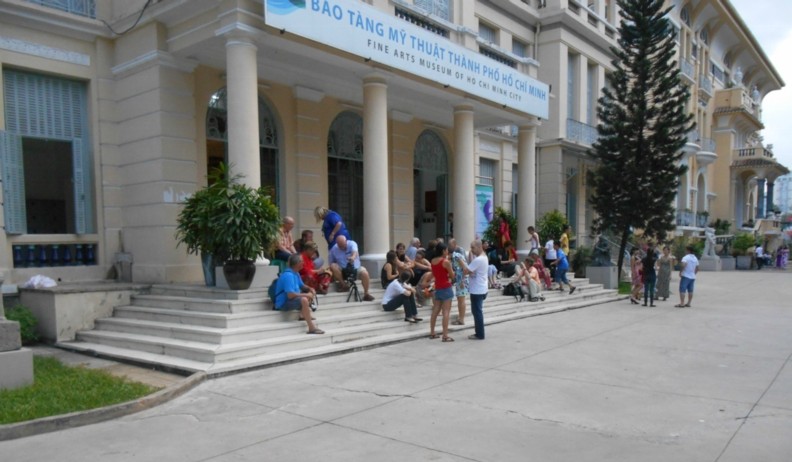
As the story goes the exhibition was arranged during the opening: a few rooms with figurative
art, a
couple with abstract art and a large hall with very expressive narrative work.
At the bottom of each work only a number was tagged and this was so for never done in
Vietnam.
Normally you do find all sorts of information underneath the works. This shows also
constantly
tormented faces of visitors who seek to understand the meaning of the work. The relationship
between the title and the artwork is quite often complicated and not always a step towards
understanding the work. Eventually understanding it is something for the future, first there
should
be interest for it and this must be aroused by the artwork itself. Finally, it is autonomous art
and it is
not illustrating of some vision.
This undecorated way of presenting art was highly appreciated by the public, "Oh, we just
have to
look? And it is not necessary to understand?"
I had a list in each hall put up of course
with the
name of the artists and its corresponding number.
It was very special for the media too. There was even a news team working for the
most
important national news channel with the question, "But what if people think something other
than
the artist intended?"
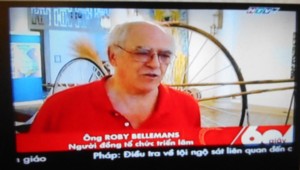
My Tran who writes for the "Saigon News," wrote this review:
Meetingpoint where Vietnamese and Dutch meet in arts
'Meeting Point Dutch Colored Art' exhibition, featuring latest artworks by 30 Dutch visual artists, took place at HCMC Fine Arts Museum in May, giving a glimpse on Dutch contemporary arts, trendy art perspective as well as stories behind color layers for Vietnamese and foreign visitors.
On display were 70 artworks, inclusive of some by 10 participating Vietnamese artists, made of varied materials from oil, acrylic, mixed media, lacquer, ceramic, iron, metal and glass. "While visiting another country, art lovers will most likely visit museums, but not everyone has the opportunity to travel unfortunately. Once exhibitions travel, they mostly take key samples on tour of historical and contemporary importance. Therefore, the "Meeting Point - Dutch Colored Art" will enable such a national visual arts summary, allowing art lovers in Vietnam to get a concrete impression of the output made by artists in the Netherlands," said Roby Bellemans, curator and organizer of the exhibition.
Visitors would admire stunning landscapes of the land of tulip in 'Home abstraction', 'Meadow fence' and 'Forest path' by Simon Borst, 'After the rain shadow light' by Hetty van der Kloot and 'Houses at the sea' by Loes Koopman. Henriette Kros and Betty Jonker also brought to the show beautiful tulip flowers made by acrylic on canvas.
Abstract paintings, that might attract contemporary art lovers by fantastic world of muilti-colors, infinite spaces and unshaped lines and dots, came on display under the talents of Ad Arma, Lia Van Velzen, Dienke Groenhout and Liesbeth Oudshoon. Portraits of beloved or unfamiliar faces were also depicted by brushes of Jolande Van Lith and Simon Stawicki.
Vietnamese people would have an intensive cultural interaction through daily activities, dance moves and souls of Dutch people. "Cultural exchange is both motivation and outcome to this project, in which Dutch artists find inspirations in local materials while Vietnamese artists learn more from their partners' points of view," said Roby Bellemans, adding that 'Meanwhile Vietnamese people can explore an insight on the Netherlands' culture and art trends."
A profound passion and charm of disco were packed in 'Art Deco Tango' series by Pin Stallman and attraction and elegance of Jazz could be seen in 'Jazz' by Jan Peter van Opheusden. Moreover, art lovers would have a chance to admire portrait of Rembrandt one of the greatest painter of European art and most important in Dutch history - in an acrylic work by Christa Logman.
The exhibition also featured some installations, sculptures and videos that were worth for Vietnamese visitors and artists to learn more about modern styles of the Netherlands. The highlight of the show was also Stefan Belleman's graffiti works, the genre that was dating back from Ancient Egypt, Ancient Greece and Roman Empire and has appeared since Vietnam in recent years.
Lia Van Velzen also raised the value of family's love and tradition while Antoinette MH Brandenburg depicted image of a Vietnamese lady cleaning in a fish market in Hoi An Ancient Town in Quang Nam Province, Vietnam. All have inspired peaceful feelings and vague dreams of characters in the paintings for visitors.
Famous and emerging artists such as Hua Thanh Binh, Nguyen Duy Nhut, Nguyen Hong Duc, Nguyen Xuan Tiep, Nguyen Thanh Nhan, Dinh Dang Giang, Hoang Ha Tung and Le Hoa also presented the beauty of Vietnamese women, preoccupation of Vietnamese youngster in the modern life, childhood memories as well as sceneries, helping Dutch understand more about Vietnamese art style and culture.
Stressing the crutial role and meaning of art, Roby Bellemans added that "Art can not only enrich the lives of interested individuals but also help anybody in the process of looking at our existence in a different way. Children are in particular important as they are the future and art has a most profound influence upon youth. Children don't know much about art so they are unprejudiced."
My Tran

